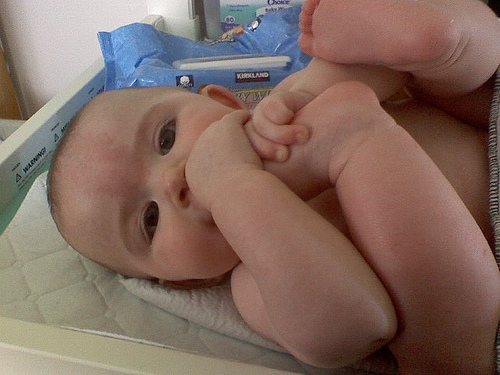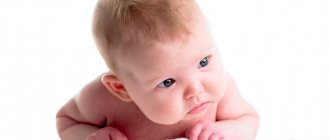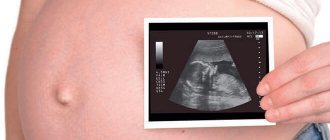Delayed motor development in children, code according to ICD 10 in children
The disorders included in this block have common features: a) onset is required in infancy or childhood; b) disruption or delay in the development of functions closely related to the biological maturation of the central nervous system; c) stable course without remissions and relapses.
In most cases, speech, visuospatial skills and motor coordination are affected.
Typically, a delay or impairment that appears as early as it can be reliably detected will progressively decrease as the child grows older, although milder deficits often persist into adulthood.
Disorders in which the normal acquisition of language skills is impaired already in the early stages of development.
These conditions are not directly related to neurological or language impairments, sensory deficits, mental retardation, or environmental factors.
Specific speech and language disorders are often accompanied by related problems, such as difficulties with reading, spelling and pronunciation of words, disturbances in interpersonal relationships, emotional and behavioral disorders.
Disorders in which normal acquisition of learning skills is disrupted, beginning in the early stages of development. This impairment is not simply a consequence of a learning disability or solely the result of mental retardation, nor is it due to a previous injury or disease of the brain.
F82
Specific developmental disorders of motor function
A disorder in which the main feature is a significant decrease in the development of motor coordination and which cannot be explained solely by ordinary intellectual retardation or by any specific congenital or acquired neurological disorder.
However, in most cases, a thorough clinical examination reveals signs of neurological immaturity, such as choreiform movements of the limbs in a free position, reflective movements, other signs associated with motor skills, as well as symptoms of impaired fine and gross motor coordination.
Clumsy child syndrome
Development related:
- lack of coordination
- dyspraxia
Excluded:
- gait and mobility disorders (R26.-)
- lack of coordination (R27.-)
- impaired coordination secondary to mental retardation (F70-F79)
F83
Mixed specific psychological development disorders
This residual category contains disorders that are a combination of specific disorders of speech and language development, educational skills and motor skills, in which the defects are expressed to an equal degree, which does not allow isolating any of them as the main diagnosis.
This rubric should only be used when there is a clear overlap between these specific developmental disorders. These impairments are usually, but not always, associated with some degree of general cognitive impairment.
Therefore, this category should be used in cases where there is a combination of dysfunctions that meet the criteria of two or more categories: F80.-; F81.- and F82.
A group of disorders characterized by qualitative deviations in social interactions and indicators of communication skills, as well as a limited, stereotypical, repetitive set of interests and actions. These qualitative deviations are a common characteristic feature of an individual’s activity in all situations.
If it is necessary to identify diseases or mental retardation associated with these disorders, an additional code is used.
F88
Other developmental disorders
Developmental agnosia
F89
Psychodevelopmental disorder, unspecified
Developmental disorder NOS
- Synonyms for diagnosis
- Description
- Additional facts
- Causes
- Symptoms
- Diagnostics
- Forecast
- Prevention
R62.0 Delayed developmental stages.
Synonyms for diagnosis
Delayed developmental stages, delayed speech development, delayed speech development, poor speech activity.
Description
Delayed speech development.
Later in comparison with the age norm, the acquisition of oral speech by children under 3 years of age.
Delayed speech development is characterized by qualitative and quantitative underdevelopment of vocabulary, unformed expressive speech, and the child’s lack of phrasal speech by the age of 2 and coherent speech by the age of 3.
Children with delayed speech development need consultation with a pediatric neurologist, pediatric otolaryngologist, speech therapist, and psychologist; if necessary, conduct a medical examination. Corrective work for delayed speech development should include psychological, pedagogical and medical assistance.
Additional facts
Speech development delay (SDD) is a concept that reflects the slower pace of development of the norms of the native language by children at the stage of early and middle speech ontogenesis. The speech therapy conclusion “delayed speech development” is valid for children under 3-4 years of age.
The tempo lag concerns the formation of all components of speech: sounds of early ontogenesis, vocabulary and grammar, phrasal and connected speech. Delayed speech development occurs in 3–10% of children; in boys 4 times more often than in girls.
Delayed speech development negatively affects the development of mental processes; therefore, mental retardation and mental retardation are often observed in children in parallel and are referred to in the literature as psycho-speech development delay (PSRD).
Delayed speech development is a medical and pedagogical problem affecting aspects of pediatrics, child neurology, speech therapy and child psychology.
Correction and development work for delayed speech development
The amount of correctional assistance for children with delayed speech development depends on the factors that caused the delay in the development of speech skills.
So, for reasons of a socio-pedagogical nature, first of all, it is necessary to organize a favorable speech environment, stimulate the child’s speech development, correct selection of speech material, demonstrate samples of correct speech, “verbalize” (pronounce) all the child’s actions.
If the basis for delayed speech development is brain dysfunction, correctional pedagogical work should be accompanied by treatment prescribed by a pediatric neurologist: taking nootropic drugs, massage, transcranial micropolarization, magnetic therapy, electroreflexotherapy, etc.
In parallel with medical procedures and family education, children with delayed speech development need classes with a speech therapist and a child psychologist on the development of speech and cognitive processes.
Particular attention in early childhood is paid to the development of fine motor skills, finger and outdoor games, productive activities (drawing, modeling, appliqué), didactic games (speech therapy lotto, special speech games and exercises), the development of visual and auditory attention, passive vocabulary and active speech , coherent speech.
Source: https://eltransteh.ru/zaderzhka-motornogo-razvitija-u-detej-kod-po-mkb-10-u-detej/
Motor development of a child
How can parents understand that their baby has delayed motor development? What is the age norm? Psychologist Marina Kozhevnikova answers these questions and gives recommendations for the development of a clumsy child.
The concept of norm and deviation
The norm of child development is understood as a set of indicators of the functioning of all systems of a child’s life. When we talk about the physiological and psychological “norm” in the development of a baby, this means that the child will easily master other necessary skills in the future. If we are faced with “not the norm”, and it can be very insignificant, then such indicators at least indicate the difficulties of developing the surrounding space. Well, then the situation snowballs. Now, for example, it is difficult for a baby to hold his head when he should already be holding it, which means that by the allotted time he will not be able to fully roll over, sit down, stand up, etc. The role of timely correction in this case is difficult to overestimate. After all, attentive attention to the successes of a toddler and timely assistance can solve very serious problems and lead the baby to normal development, and therefore to the most successful prosperous life in the future.
Motor development of children
This question is incredibly important because by assessing the movements of a young child, you can gain a comprehensive understanding of his nervous system. And, oddly enough, it develops largely thanks to movements. Here is a simple example: when a baby learns to sit, he receives a powerful stimulus for perception, because now he sees everything from above and in several planes at once. In turn, new perception forces the memory to capture new sensations, and the baby gains new experience. In his passive speech (which the baby hears and knows) new words appear, which will then turn into their own active speech. Finally, in the process of sitting upright, new muscles are hardened, new ligaments are stretched, and the skeletal system is strengthened. Can you imagine what a powerful chain this turned out to be? How many such chains are formed during the daily development of a small person?
Motor skills by month
Up to 1 month
During this period, you should not expect miracles from the baby’s motor sphere. Movements are limited, arms and legs are pressed to the body, the baby likes to curl up. Why is this happening? The baby needs time to get used to new living conditions. Which takes about a month.
1-2 months
The baby begins to smile and actively move his arms and legs when his beloved mother appears. The revitalization complex, which is what experts call the way out of “embryonic hibernation,” triggers powerful motor development and, accordingly, mental development as well. During this period, babies begin to hold their head suspended from a position on their tummy. Mothers should pay close attention to massage and regularly place the baby on a hard surface. At first a minute is enough, but every day the time needs to be doubled.
2-3 months
Further more. By the end of the period, the little one easily stands like a candle, holds his head straight, turns it to follow the flight of interesting thoughts. In a word, he masters the space to the fullest. Another indicator of normal motor development is active, vigorous movements of the arms and legs. So tight diapers and clothes are a gross obstacle to liberated movement. If you see a hint of stiffness, or when one arm/leg moves more actively than the other, this is a reason to contact your pediatrician and undergo a massage course. The baby most likely has increased tone, which in itself is not uncommon.
4th month _
At this age, it is already difficult for you to recognize your baby. He begins to raise his head while lying on his back. They easily turn over from their back to their side and try in every possible way to change the position of their body in space. He also happily rests his legs on a hard surface if you take him under your arms. Yes, this is the very age when you try to “escape” from the couch on your own. Drawing in the legs and reluctance to actively move the body certainly alarms parents and is an indication for consultation with a neurologist and massage therapist. By the way, now and in the future, toys are the most appropriate stimulation of development. New, bright, favorite, unusual... Place them near the child, a little further, so that you want to stretch, crawl, reach the desired object.
5 months
The baby loves to lie on his tummy and rest his palms on the bed. So, standing up, making the first attempts to crawl (real crawling is still a long way off), rolling over from back to tummy and back, reaching out and grabbing toys, stepping with your legs, hanging in the arms of your parents - all these are achievements of this period.
6 months
In the second half of the year, the baby increasingly demonstrates independence and a degree of mastery of the environment. Now reaching the toy is no longer a problem, and from a variety of positions. Reach, crawl on your tummy, turn around and roll over. There is no hindrance to the baby's interest. The real crawl is about to begin. And it is very useful, as it is an excellent stimulator of blood circulation and muscle exercise. Therefore, encouraging crawling is the main vertical of attention of all caring parents.
Another good news is sitting with a straight back. It may still be difficult for the baby to hold his back on his own, but with the help of his mother he does it perfectly!
7 months
Sitting, manipulating a toy, rising to one’s feet with the help of parents, stepping firmly and generally feeling free in the surrounding space is the prerogative of this age.
8 months
The little one enjoys playing with a pyramid, buckets and balls - moving, putting, stringing, throwing, sucking, holding out toys. Gives him a pen and is actively interested in his fingers. Stands up and sits down independently in his crib. All these actions are very complex and require true skill from the baby.
9 months
The baby stands firmly on his legs and walks very confidently, holding onto both of his mother’s hands with his hands. He likes to play while sitting, crawls well, takes toys from shelves, and can climb on and off the sofa. Tries to manipulate several objects at once, puts them in a container and places them in front of him.
10-12 months
The toddler moves from toy to toy, bends down, and squats. Even if he does not yet walk on his own, he easily moves, holding onto the wall with one hand. However, some people are already starting to run on their own. But mainly, all manipulations become more subtle. The baby can play with rings, saucepans, and balls for a long time. Trying out the first artistic techniques if mom allows crayons or finger paints. Jars are a subject of particular passion for the little genius. Open, close, arrange - what could be more interesting. Games appear in the sandbox or at home with loose objects. The baby grabs small parts or grains of sand with his fingers, his movements are very precise.
IMPORTANT!
Only a pediatrician and a neurologist can determine the degree of normality and deviation of development. Therefore, a thorough examination of the child by specialists is a mandatory program for young parents. Communicate more with your baby, play, sing songs... After all, every active action you take is a coin for the baby’s further development.
Delayed motor development or immaturity? Conversation with a neurologist
Evgenia Tikhomirova , a pediatric neurologist, answered common questions from parents about various child delays in the development of motor activity. Let's start with the fact that not every delay is a reason to diagnose MMR. Often we are talking about immaturity of the brain.
Child's readiness for skill
- When does it make sense to panic? Are there clear signs that we are talking about delayed motor development? And when do we talk about simple immaturity?
— It is important to understand that MCH is a symptom of some problems in the child.
If it lags behind, then the question is why? One of the reasons is damage to the nervous system at birth, which occurs with prematurity, severe hypoxia during childbirth, artificial ventilation, etc.
When assessing a child's development, doctors must take these risk factors into account. We keep an eye on children at risk and do not allow them to be “lazy”: in their case, MR will be considered a sign of the formation of pathology (cerebral palsy), so early intervention is necessary.
In addition to damage to the nervous system during childbirth, there are many reasons for delayed development: development is affected by malnutrition, anemia, food intolerance, heart defects, various metabolic disorders, genetic syndromes, etc. Therefore, when examining a child, we pay attention to additional symptoms, and not just the fact of the presence of the skill.
In general, neurologists are more interested not in the fact of the presence or absence of a skill, but in the child’s readiness for it. For example, three children at 4.5-5 months do not roll over onto their stomachs. For parents, they are all the same “lazy people”, but in reality the situations are different and the approaches to treatment and diagnosis are different:
- One is lethargic, like a rag, can’t hold his head up well, rises on his stomach on his elbows for a short time, doesn’t stretch his arms, there’s no support;
- Another with normal muscle tone lies on his stomach for a long time and lifts his body, straightening his arms, but turns over only with the help of an adult;
- The third one does not lie on his stomach at all, roars, and immediately tries to roll over back.
So, if the pediatrician and neurologist have no complaints about the child, then there is no need to panic. Healthy, but not ripe. And if there are prerequisites for MR, according to anamnesis or examination, then wait for a delay.
Children can't be lazy
— Could you clarify again which children are at risk? Whose mothers should be especially attentive?
— Risk factors are as follows:
prematurity less than 35 weeks; Apgar score - 5 or less; mechanical ventilation after birth; jaundice more than 300 µmol/l; intracranial hemorrhages, moderate and severe hypoxia; large fetus, application of forceps/vacuum extractor; if developmental regression (loss of previously acquired skills); if there were convulsions; if a child over 2 months reacts little to others, is unemotional, does not roar;
if at 3 months he does not hold his head and does not lift it while lying on his stomach, at 6 months he does not roll over, at 9 months he does not sit/crawl, and at one year he does not stand on his legs (these are deadlines).
— Common arguments from mothers on forums are “Everything is individual” or “He’s just lazy.” How long can you use such words to justify your own inaction?
“Children don’t know how to be lazy.” If they are lagging behind, then there is a reason. The lag is meant beyond the boundaries of any norms. Let’s immediately define what normal and lag mean. There is a “majority norm,” that is, when most children master a skill. And there are limit values: the time frame within which healthy children master a skill is wide. See WHO table.
Translation of the table from the site Mamazanuda.ru
Are children not touched abroad? It is a myth!
— How important and is the sequence of mastering skills important?
- There are two things here. On the one hand, the end result is important: walking. But on the other hand, there are laws of brain development, according to which everything should be gradual. Violation of the stages indicates some kind of trouble, and that the child is somehow overcoming this trouble.
After all, in fact, children have a large margin of safety. For example, if a child, due to disorders in the cervical spine, does not lie on his stomach, he will not roll over onto his stomach for a long time, he will roll over from his stomach to his back (although this is more difficult). Doesn't crawl, sits down and gets up immediately.
Everything seems to be fine, the problem has been corrected.
An example from life: my son crawled on his belly at 6 months, stood up against a support at 8 months, sat up from a standing position at 8.5 months, crawled on all fours at 9 months, walked at 11.5, and everything seemed to be fine.
But then problems emerged: weak back muscles, which affected my posture (that’s why I sat down late); difficulties with coordination: for a long time I could not master a bicycle, skates, difficulties in performing new exercises, clumsiness.
And I’ll add about non-crawling children (according to statistics, there are 10%): they are at risk for problems with coordination, writing and reading. Although this is not necessary.
— There is an opinion that abroad a child under two years of age is not touched at all - when he masters his skills, then he will master them. What do you say about this?
— There is no such thing abroad, it’s a myth! The table shows the standards of the World Health Organization.
If the child is very premature, there have been serious operations, injuries, illnesses, then yes, the dates are shifted somewhat.
Moreover, in case of deviations, the diagnosis of cerebral palsy - the term cerebral palsy is used abroad (its essence is a movement disorder, that is, delayed motor development) must be established before 2 years of age (or earlier).
To be continued about massage, injections, nootropics and physiotherapy...
If you want to receive our articles regularly, join communities on social networks VKontakte and
Photo by Ksenia Kudrina. Translation of the mamazanuda.ru table
Source: https://uparents.ru/zaderzhka-motornogo-razvitiya-ili-nezrelost-beseda-s-nevrologom-chast-1/
Delayed motor development in children
Home»Psychosomatic disorders»Delayed motor development in children
Published: May 24, 2012 at 07:02

The birth of a baby is a holiday, which is invariably followed by daily worries and worries, the need for training to care for the baby, and worry about his health. Parents in the family are forced to change their usual way of life, watching their child every day and hour. The most stressful is the first year of a child’s life, when all the mother’s attention is focused on whether he has learned something in one day, week, month.
Features of motor development
When babies are still very young, parents want them to grow up as quickly as possible, to start sitting, crawling, and running. Sometimes it becomes a real competition with the child who lives next door. However, motor skills in children largely depend on the preparation of the body, the parts of the brain responsible for balance and posture. And even if they all work, the child will not be able to sit or move while the muscle structure has not changed enough to support the body weight and do the work required for movement. The baby will begin to sit, grab toys, crawl and walk only when his brain and body reach the necessary development. And this is programmed at the genetic level, and also depends on the health of mom and dad before conception, family predisposition to various diseases, chronic diseases of the mother before pregnancy, acute infectious diseases during pregnancy, drinking alcohol and smoking.
Whether your baby begins to walk at 8 months and 5 days or at 10 months and 7 days will depend on the motor development program he inherited. If he starts sitting early, this means that he will acquire other skills early. But there is no evidence that babies who walk early are more likely to be athletes or dancers than babies who walk late, nor that babies who crawl and walk early are more likely to do well in school than those who don't. who will develop these skills later.
Patterns of motor development

In the first month of life, the baby still retains the increased tone of the flexor muscles inherent in the period of development inside the womb, so its movements are limited. Only muscles that serve the most important vital functions act. Muscles begin to develop rapidly from the first month, but this happens gradually. The muscles of the neck become functionally mature first. At the beginning of the second month of life, the baby raises his head for a short time while lying on his stomach. To strengthen the muscles at this time, you need to lay the baby on his stomach several times a day, on a flat, hard surface, gradually increasing the duration of laying.
After the neck muscles, the muscles of the limbs and torso develop, so the baby will need loose clothing that does not restrict movement. If children are deprived of the opportunity to actively move, they will develop worse, having difficulty developing coordination of movement. At 2 months, the baby will hold his head for several minutes, turning it to the sides. By the age of 3 months, children develop a revival complex - chaotic, active movements of their arms and legs in response to their mother’s appeal. This way the child will try to grab the toy, so it needs to be hung so that the little one can reach it with his hand.
When placed on the stomach at this stage, the baby raises his head and upper body, focusing on his forearms. 4th month - the baby can raise its head from a position on its back, rise, and tries to change its body position, turning from its back to its side. From the fifth month, the child raises his torso, lying on his tummy and leaning on his palms, turns from his back to his tummy, steps with his feet supporting his torso, and takes toys. The 6th month gives the baby freedom of action: he begins to crawl to get a toy, which contributes to the rapid development of back muscles, affects posture, and improves blood circulation. Therefore, parents should encourage these beneficial activities and help the baby crawl.
From the 2nd half of the year, the toddler’s efficiency and accuracy of motor skills increases. By 7 months, he transfers toys from hand to hand, knocks toys on different objects, crawls well, and can stand with support. Children master the ability to sit perfectly by 8 months. Therefore, stimulating them earlier is not appropriate, and besides, it is harmful, since fragile muscles do not hold the spine well, and it becomes curved. Only independent attempts by the baby to sit down or stand up, supported by the crib, indicate the necessary muscle strength. By 8 months, the child will be able to lie down, if necessary, stand up, grab the crib, and give a hand. At the ninth month, the baby can stand well with support, step over handles with support, climb on objects, becomes dexterous, and turns his body while playing. As for walkers, it is better not to use them, because when the baby gets tired of moving or sitting in them, he is not able to lower himself, lie down or crawl. When walking in a walker, the baby leans forward, which is harmful for the spine and mastering a vertical position. 10th month - the toddler bends down, kneels down when playing, holding on with his hand, moves from object to object, opens and closes boxes, puts object into object. At 11 months, the baby stands for a long time and walks with the support of his hand, begins to climb up the steps, and tries to crawl off the sofa on his tummy. He plays with pyramids and boxes, tears and crumples paper. At one year old, the baby can stand firmly on his feet, walk, climb steps, and carry objects with both hands. He loves to fill boxes, throw toys, and pull them behind him. The freedom of movement of such a baby is dangerous; he can come into contact with hot and piercing objects, which leads to injuries, burns, and small objects getting into the nose, mouth, and respiratory tract. A one-year-old child should not be left out of sight, because his motor abilities can lead to an accident.
The following chart of baby development only indicates the order in which motor skills should develop. But if your baby is different from other children in his motor development and behavior, this does not mean that he is behind in development. It may have its own individual periods of development. But if by a specific age he has not developed the appropriate motor skills and functions, we are talking about a delay in the development of this child’s motor skills.
Signs of delayed motor development
To determine a disorder in a child’s motor development, you need to know these signs of motor impairment, which appear even before the ability to sit, walk, crawl, and play with toys is formed. Call your pediatrician's attention if:
- at the end of the first month the baby does not hold his head vertically for a moment;
- at the end of the second month does not lift the head 5 cm from the surface and does not hold it, continues to make asymmetrical movements of the limbs;
- at the end of the third month, the child does not hold his head upright for half a minute, and lying on his tummy for a minute, does not look at his hands, does not reach for the toy that you hold in front of him;
- at the end of the fourth month, the baby’s head tilts back; if you lift him from a lying position, he does not lift his torso, lying on his tummy, leaning on his forearms; in a vertical position with support under his arms, he does not lean on his toes;
- at the end of the fifth month, the baby unsteadily holds his head, especially if you lift him from a lying position, turns poorly from his tummy to his back, and hesitantly reaches out his hand to the toy;
- at the end of the sixth month, does not reach the toy when lying on the stomach, does not grab it, does not move it with its legs when supported under the armpits;
- at the end of the seventh month, the toddler, supported by his mother’s hand, does not try to sit up;
- at the end of the eighth month does not crawl back, does not stand with support, does not hold a button between the fingers;
- at the end of the ninth month, he has poor balance when sitting, does not turn around an axis or crawl forward, does not pull off his cap, and does not drink from a cup on his own; at the end of the 11th - the baby does not crawl, does not sit with its legs outstretched, does not try to stand and move, holding onto support;
- at the end of the 12th - cannot take a couple of steps while holding mother’s hands, cannot hold two small toys with one hand, or does not give toys to an adult.
Delayed psychomotor development in children: main causes and their treatment
- 1. Causes of delay in a child
- 2. Symptoms and diagnosis of mental retardation
- 3. Treatment of psychomotor development
- 4. Prevention
Over the past decades, the number of children diagnosed with delayed psychomotor development has increased.
A child with such a diagnosis has an urgent need for medical and educational intervention in development.
In most cases, a pronounced delay in speech development in a child is accompanied by a violation of visual-spatial skills and motor awkwardness, and subsequently a lag in mental development from his peers.
Therefore, the term “psychoretical development” is also used. The anomaly occurs in boys much more often than in girls. The total prevalence of pathology in the general structure of mental illnesses is 8-10%.
Causes of delay in a child
When a child’s development is delayed, a hereditary burden is most often noted - the presence of similar or related disorders in the parents, which indicates the large role of genetic factors in the occurrence of most, but not all cases. Environmental factors also have a certain influence, but their role is less significant. The underlying causes of psychomotor development delay (PDD) vary, so the deviation is usually classified into:
- primary – formed against the background of organic damage to the brain or disruption of its functions;
- secondary – occurs when the brain structures are initially intact and there are severe somatic pathologies, for example, heart disease, which are accompanied by cerebral insufficiency.
The following factors can cause primary pathology in a child:
- diseases of a woman during pregnancy - introduction of an infectious agent, intoxication, injury;
- oxygen starvation of the fetus;
- complicated labor;
- injuries during labor - damage to the brain and/or spinal cord, dysfunction of the central nervous system (perinatal encephalopathy).
Secondary delay in psychomotor development in children under one year of age can be triggered by the following systemic pathological features:
- congenital abnormalities of the central nervous system;
- mental illness;
- hydrocephalus;
- increased ICP;
- cerebral palsy;
- brain tumors;
- abnormalities of blood supply to the brain;
- progressive cerebral sclerosis (leukodystrophy);
- disruption of cerebrospinal fluid transport.
The cause of development of mental retardation in the postpartum period is infectious pathologies and various (including mental) traumas suffered at an early age.
Depending on the cause of the violation, the ZPR is classified into:
- constitutional;
- somatogenic;
- psychogenic;
- cerebral-organic.
The child’s condition largely depends on family relationships. Severe delay in psychomotor development, according to statistics, most often occurs in children from asocial families. Provoking factors for deviation are abuse, lack of care, and violence. But it is characteristic that with overprotection, children may experience the same anomalies as with attention deficit.
Symptoms and diagnosis of mental retardation
Psychomotor development delay according to the ICD-10 code belongs to the class F80-89 - “Disorders of psychological development”. In a child with congenital causes of mental retardation, signs of retardation may appear at an early age. Symptoms of abnormalities in children of different ages may vary:
- at 4 months – there is no reaction to the gestures and words of the parents, there is a deficiency of emotional manifestations;
- at 8-9 months – there are no attempts to pronounce incoherent syllables or the so-called “baby talk”;
- at 12 months – decreased motor activity is noted, others consider the baby to be quiet, shy, silent;
- at 1.5 years – there is no adequate reaction to one’s own name, simple requests; the baby does not pronounce simple words, incoherent speech, lack of understanding of what is being said to him, in addition, he may have a lack of chewing skills;
- at 2 years - poor speech, with a limited vocabulary, no desire to repeat new words;
- at 2.5 years – the vocabulary is minimal (no more than 20), represented by a set of scattered words, the child does not know how to construct coherent sentences from them;
- at 3 years – communication is limited due to incoherent, incomprehensible speech; the child may simply repeat phrases without realizing their meaning.
In addition to signs of deviations in the formation of speech function, with mental retardation there is a delay in mental maturation - rapid fatigue, immature emotional-volitional function, deviation in thinking (underdeveloped imagination, limited memory capacity, inability to switch attention, difficulty perceiving new information). A reduced mental level and a limited range of emotional manifestations make it difficult to communicate with peers. These children often have characteristic features of syndromes associated with genetic abnormalities.
Visual signs of developmental delay.
Children with mental retardation are characterized by a desire for pleasure, so they quickly give up activities that require concentration and tension; play activities are, as a rule, primitive in nature.
Disorders of mental and speech development can be combined with a delay in physical maturation; sometimes mental retardation is adjacent to cerebral palsy.
The signs of the pathology are in many ways similar to the symptoms of other mental disorders, for example, autism, attention deficit hyperactivity disorder. To make a correct diagnosis, differential diagnosis is necessary.
Children are interviewed and special tests are conducted to assess the level of development of the emotional-volitional sphere, the ability to communicate with others, as well as attention, memory capacity, and features of logical thinking. In addition to psychological and pedagogical examination, a medical examination is prescribed, which is carried out using:
- MRI, CT;
- electroencephalography (EEG);
- VP research.
These techniques make it possible to detect structural disorders of the central nervous system and anomalies of the speech center in a child. A set of techniques allows you to make an early diagnosis and start treatment in a timely manner. Without proper treatment, problems deepen, affecting not only character and interpersonal relationships, but also social status.
Treatment of psychomotor development delay
Children with mental retardation need the help of doctors of various profiles: neurologists, psychologists, speech therapists and speech pathologists. Treatment should take place according to an individually developed system and include:
- medicinal effects - medications are selected by a pediatric neurologist depending on the cause and severity of the pathology;
- physiotherapy - massage, hydrotherapy, special therapeutic exercises;
- transcranial magnetic stimulation - the impact of current pulses on certain nerve centers of the brain through the cranium.
Psychologists and speech therapists help the child master speech skills by using special techniques for stimulating speech activity and interpersonal communication skills in play and object-based activities.
All analyzers are affected - visual, auditory, tactile, because
they have a connection with speech, motor and other centers of the nervous system and their irritation stimulates the functions and activity of brain activity.
To activate the emotional-volitional sphere, psychologists work with children at the Manual Medicine Clinic “Galia Ignatieva MD” using:
- art therapy;
- fairytale therapy;
- play therapy.
Specialists use techniques for training attention, increasing memory capacity, stimulating logical thinking and perception. The result will depend on the support of parents, as the process must be continuous.
Home activities to develop fine motor skills in a girl with mental retardation
It has been found that fine motor skills help to activate thinking and speech. Therefore, if a child has a delay in psychomotor development, treatment includes modeling, design, and assembling puzzles.
At the Manual Medicine Clinic “Galia Ignatieva MD” we treat such disorders using innovative treatment methods, which necessarily include methods of physical development - physical education, special exercises, active games. The motor mechanism is also associated with the psyche.
The mechanism of influence on the child’s central nervous system is multifaceted and requires patience, regular work, and cooperation of doctors, teachers and parents.
Therefore, it is recommended to place children with psychomotor retardation syndrome in special groups of preschool and junior school institutions.
These groups are available in specialized institutions of the VII type, in which children are helped to adapt to the social environment, learn to communicate with peers and adults around them, and not depend on the help of adults in basic everyday activities.
Delayed psychomotor development in children, which is treated according to an adequately developed scheme, has a good prognosis. With early detection of signs of an abnormality in a child and an integrated approach, the characteristics of the psychomotor state can be successfully corrected.
Prevention
Delayed psychomotor development, the prognosis for treatment of which is favorable in most cases, requires a special approach, long-term complex influence, and dynamic observation of specialists. According to scientists, the number of children with mental retardation will continue to grow if preventive measures are ignored:
- plan pregnancy in order to exclude hereditary anomalies, disorders of the formation and maturation of the central nervous system;
- be regularly observed by a specialist during gestation, promptly identify systemic diseases;
- pay attention to the psycho-emotional state of children and engage in their development.
Parents should know the age characteristics of the child, norms, signs of anomalies in the formation of mental, emotional, speech skills and timely note them, seeking professional help.
Source: https://beautyvertebro.com/zaderzhka-psixomotornogo-razvitiya-u-detej-osnovnye-prichiny-i-ix-lechenie/
Motor development of a child: first half of the year
You shouldn't expect miracles in the first month. The baby is just beginning to get used to the new condition. The long intrauterine position and limited space have given rise to hypertonicity of the flexor muscles: the arms and legs of the newborn are constantly bent, pressed against the body, and his movements are constrained. Noticeable dynamics are observed only at the end of the first month of life. Initially, the neck muscles begin to strengthen: lying on the tummy, the baby can raise his head for a short time. However, it is worth remembering that success is achieved only with the help of parents. To avoid delayed motor development in children, it is necessary to place the newborn face down on a hard surface every day. In the first days, one minute is enough to complete this exercise, then the time increases.
Motor development of a child in the second month of life is characterized by strengthening of the neck muscles. Lying on his stomach, the baby raises his head more and more confidently every day and holds it vertically for one to two minutes. Hypertonicity in the baby's arms becomes weaker and disappears completely by the end of the month. Take the child under the armpits, you will notice that he already knows how to rest his legs without bending his knees. Grasping movements develop and improve; the baby can hold an object placed in his palm for several seconds.
At three months, the baby’s neck muscles are already so strong that he is able to hold his head well and for a long time while in the “candle” position. In addition, at this time the muscles of the arms are actively developing. As a result, the ability to lean on your forearms and raise your head high while lying on your tummy appears. The child can push off from a hard surface by flexing the hip joints.
At the fourth month of life, a sharp jump in the child’s motor development is observed. His movements become more conscious and coordinated, the baby already grabs and holds objects, can roll over from his back to his stomach, and rise. Hypertonicity of the legs completely disappears, due to which the baby confidently rests on a hard surface with half-bent legs.
In the fifth month of life, the child’s motor development improves. He rolls over onto his back and back, holds the toy tightly in either hand, lies on his tummy for a long time, and from time to time rises up on his outstretched arms. In addition, the child begins to learn to sit.
Having consolidated his skills, the 6-month-old baby strives to master new horizons. He no longer only wants to lie down, sit and roll over. He begins to explore the surrounding space and tries to crawl. At this stage, the child’s motor development occurs at an accelerated pace, so it is important not to limit his motor activity. Do not keep your baby in a crib, playpen or high chair for a long time. Lower it to the floor, help the baby master crawling skills. After all, moving around the room, he not only improves the musculoskeletal system, but also learns about the world. At the same time, at six months the child can already independently take an object in one hand, transfer it to the other, or throw it. If you hold your baby in an upright position, he will make full walking movements.
Delayed motor development in children under one year of age
A delay in the rate of motor development or a delay in the development of motor skills in a child under one year of age is quite common.
Is this dangerous for the child? What are the consequences of falling behind in skill acquisition?
In such situations, there is no need to sound the alarm and start panicking.
It is important to understand that established time frames for the acquisition of motor skills are not absolute and may vary for individual children.
There are special indicators of age-related norms for mastering complex movements (rolling from the stomach to the back and back, crawling, walking, etc.), which help parents navigate this area. Moreover, if a lag is really observed, you should always contact a pediatrician due to possible unpleasant and even disabling consequences.
The appearance of a lag in the development of motor skills can be associated with a number of factors - both genetic characteristics and environmental factors, diseases of the baby, etc. It is especially worth highlighting the following most common causes of delayed motor development in children at 8 months and at any other age:
- Various types of congenital encephalopathies associated with adverse effects of the environment or the maternal body on the developing brain of the fetus.
- Infectious pathology, both of the mother during pregnancy and of the child in the first months of life.
- Congenital defects of the heart, lungs, musculoskeletal system, etc.
If a developmental delay does occur, it is always necessary to seek qualified medical help, primarily aimed at identifying the causative factors of such a delay in motor development in the baby, as well as drawing up an individual program for correcting the development of motor skills.
Manifestations of delayed motor development
The acquisition of motor skills occurs through well-known age periods. For each month of a child’s life there is a certain motor act, reflecting the development of the brain and musculoskeletal system.
- At the age of one or two months, a child can practically do nothing. He is only able to fix his gaze for a few seconds and move his arms and legs chaotically. It is almost impossible to identify a lag in the motor sphere at this stage. However, an experienced physician can identify excessive increases or decreases in muscle tone and other characteristic symptoms that may indicate severe brain damage.
- If the baby does not try to get up when lying on his stomach and does not tilt his head, then most likely there is a delay in motor development, which should be addressed immediately to a medical facility.
- In the sixth month of life, the baby does not turn over from back to side and stomach, and also back. This situation can be associated with a number of factors, many of which are physiological and do not pose a threat.
- If the child is already eight months old, and he still does not try and cannot crawl, then it is worth contacting a pediatrician for advice and additional examinations.
- By the end of the first year of life, any baby should already take at least a few steps, including with the support of his parents. If this does not happen, there may be a delay in motor development that requires medical evaluation.
The World Health Organization offers fairly wide age ranges for the development of motor skills. Therefore, excessive worries and anxiety of parents should not appear in cases where the baby lags behind in his motor development by a couple of weeks or months. This process is very individual.
Tempo delay in motor development//Rickets
These are the terrible diagnoses given to our baby...
I'm desperate! I’m so tired of worrying, I don’t have any strength anymore! What caused this delay, I still don’t understand...
Everything is in order. The baby was born at exactly 39 weeks, Apgar 8/9. Up to 4 months development corresponded to the timing (I remember, at about 4 months, I noticed that she was now an eye and an eye - she had become so active and fidgety. She walked incessantly, very briskly spinning on her side or on her back around her axis, it seemed that it will start to turn over).
at 4.5 months I got a little tense because Sofiyka still didn’t turn over... and in general she became kind of restless, passive, and practically stopped walking. She began to sleep poorly, began to scream at night (for example, she sleeps calmly and suddenly screams, then only wakes up all in tears). We attributed this either to the change in weather or to the teeth (the first one hatched at 5 months 5 days). At the same time, my daughter began to actively scratch her head, especially the back of her head (I associated this with a crust on her head, I even wrote a post). At the same time, her hair began to fall out greatly (she has had long hair since birth), but her head did not go bald, but there was hair left on her pillow/cap, like after a heavily shedding cat! My mother-in-law said that I was making everything up, that this was normal and that my hair was changing. The pediatrician also ignored this issue. After 1.5-2 weeks everything suddenly stopped by itself. Immediately after this (at about 5.5 months), the baby began to wake up frequently at night (I practically stopped putting her back in the crib after feedings), especially in the morning, she began to moan somehow, cry with her eyes closed, and refused to breastfeed... This continued It took about a week or two and it stopped (at that time the second tooth was coming out). By the end of 5 months. The baby’s behavior returned to normal, she again began to actively walk and talk about something, but! I was always lying on my back! She doesn’t like to be on her stomach at all and won’t turn on her stomach! Only from the stomach to the back.
In this regard, at exactly 5 months we went to a neurologist. She tried on her head, muttered something about the back of her head, and prescribed Aquadetrim 4 drops/day until the end of May. She practically didn’t examine the child and started writing on the card from my words. When I said that the child did not roll over, my eyes widened and I diagnosed him with delayed motor development. She sent me for electrical back stimulation and massage (cito). Went for SMT and massage - 0 effect! The baby is already 6 months old and nothing has changed. And then I slowly start to panic! I’m reading the feed, my peers are almost running around, but ours is lying to itself and there’s not even a trace of any attempt at active activity! Finally managed to get to another neurologist in our regiment (everyone praises her). She looked and voiced the diagnosis of tempo delay (saying that it was nothing critical, she just got better later). I sent her for NSG monitoring and prescribed: Neuromultivitis 1/4 (No. 20), Fish oil (1/2 tsp each) and begin massage and exercise therapy. At home, I looked at the map and almost fell - in the status: head shape - Hydrocephalus...). Conclusion of the NSG: enlargement of the bladder, accumulation of fluid on the convenital surface, vascular dyscirculation…. Where did this come from?? They did it for a month, everything was normal! The neurologist said there was nothing wrong and added Pantogam to the treatment. After the neurologist, we went to the pediatrician, who became attached to me with DPT! “Yes, everything is fine with you, why are you so worried?” Feeling the fontanel, she knitted her eyebrows thoughtfully. I asked what was the matter and then she said: “You have rickets. Subacute course. You were prescribed fish oil. Everything will be fine. Now all city children have rickets.” Since then I have been in some kind of prostration. Rickets is such a serious disease!!! Officially, there is not a word about this in our map! I literally beat the diagnosis out of her! Why do doctors take him so lightly?? Why were the described symptoms ignored (I didn’t know then that these were symptoms of rickets!!!), because in modern conditions this disease can be easily prevented!!! And even now no one tells us to take blood and urine tests (by the way, we took them only 1 month - six months ago!!!), treatment is prescribed “by eye”, but hypervitaminosis D is very dangerous!!!
We started massage at home (results are visible in 2 weeks, but the masseuse said that we are about 2 months behind!!! and this is due to rickets....). She said that the arms and back are very weak and the child should not be sat down under any circumstances! But our orthopedic surgeon was indignant that at 7 months the child was not yet sitting and said that at our age it is mandatory to sit down!
Girls, has anyone had a similar situation? How were you prescribed treatment? How fast/long does the recovery process take? Maybe I should take some vitamins (we are on breastfeeding)? What other tests should I take? I'm afraid to miss time.
Thanks to everyone who responds!!!







